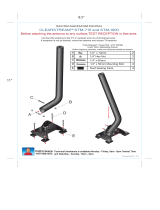
User’s Guide · IPS – IPT – IPQ – IPLanTVManager
- 1 - IPS – IPT – IPQ – IPLanTVManager Version_en_1.0 FTE maximal
Index
1. Initial installation.....................................................................................................................................................................................................................................................2
1.1. Safety measures...................................................................................................................................................................................................................................2
1.2. Box content...............................................................................................................................................................................................................................................2
1.3. Description and connections.......................................................................................................................................................................................................3
1.4. IPLanTVManager Installation user’s guide......................................................................................................................................................................3
1.5. First connection of the modules...............................................................................................................................................................................................4
1.6. Accessories and examples of installations......................................................................................................................................................................6
1.6.1. Accessories........................................................................................................................................................................................................................................6
1.6.2. Examples of installation...........................................................................................................................................................................................................7
2. DVB-IP...........................................................................................................................................................................................................................................................................8
2.1. Operation Modes ..................................................................................................................................................................................................................................8
2.1.1. SPTS Mode........................................................................................................................................................................................................................................8
2.1.2. MPTS Mode.......................................................................................................................................................................................................................................8
2.2. Searching devices................................................................................................................................................................................................................................9
2.3. Management Tasks.........................................................................................................................................................................................................................11
2.3.1. Configuration of the device parameters..................................................................................................................................................................11
2.3.2. Configuration of the LNB parameters (DVB-S / DVB-S2).....................................................................................................................12
2.3.3. Firmware Update........................................................................................................................................................................................................................13
2.3.4. Initialization ......................................................................................................................................................................................................................................13
2.3.5. Suspend and Resume............................................................................................................................................................................................................13
2.3.6. Management of the slots “Common Interface” (-CI).....................................................................................................................................13
2.3.7. Events Logging............................................................................................................................................................................................................................13
2.4. Configuration.........................................................................................................................................................................................................................................13
2.4.1. Streaming Mode..........................................................................................................................................................................................................................14
2.4.2. Search for the available services/frequencies...................................................................................................................................................14
2.4.2.1. Manual search in DVB-S, DVB-S2, DVB-T and DVB-C devices..........................................................................................15
2.4.2.2. Automatic search in DVB-S, DVB-S2, DVB-T and DVB-C devices...................................................................................16
2.4.2.3. Service/Frequency list.............................................................................................................................................................................................18
2.4.3. Definition of the streaming services...........................................................................................................................................................................21
2.4.3.1. Definition of a streaming service from an existing service/transponder in database .........................................22
2.4.3.2. Definition of a streaming service from an existing streaming service (SPTS)...........................................................22
2.4.3.3. Definition of a streaming service with no previous service reference (SPTS)...........................................................22
2.4.4. Start and stop a streaming service ..............................................................................................................................................................................25
2.4.5. Configuration of DVB-S/DVB-S2 devices sharing the same antenna..........................................................................................25
2.4.6. Configuration of services in devices with “Common Interface” option...........................................................................................26
3. Technical features.............................................................................................................................................................................................................................................27
4. Declaration of conformity ............................................................................................................................................................................................................................29





















